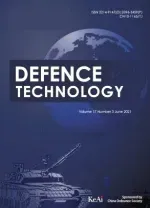Research on Hybrid Power System with Dual Stator-winding and Its Decoupled Control Strategy
2012-07-25WEIShuguang魏曙光MAXiaojun马晓军KERongshuo可荣硕LIUQiuli刘秋丽
WEI Shu-guang(魏曙光),MA Xiao-jun(马晓军),KE Rong-shuo(可荣硕),LIU Qiu-li(刘秋丽)
(Department of Control Engineering,Academy of Armored Force Engineering,Beijing 100072,China)
Introduction
Currently,DC power systems of 28 V are applied widely in most armored vehicles.With the increase of electric equipment,the heavy current in low-voltage power supply leads to wide cables and some puzzles,such as insufficient electric power,difficult component layout and hard design of power converters.Therefore,a reasonable dual-power system of 28 V and 270 V based on dual-stator winding will be widely used in future armored vehicles.
A dual stator-winding PM synchronous generator was given in Ref.[1].But,two DC/DC converters are necessary to stabilize 28 V and 270 V separately,thus,it is not suitable to be used in the narrow space of armored vehicles.
Another study on squirrel-cage induction generator with separate dual stator-winding(power winding and control winding)and its PWM-VSI control method was mentioned in Ref.[2 -4].Its power stator winding can set up single voltage,but the control stator winding is unable to give power.In order to get stable 28 V and 270 V simultaneously,the control winding mentioned above acts as 270 V power winding and the original power winding outputs 28 V in the hybrid generation system.Two voltages are decoupled on the basis of the instantaneous reactive power theory and control method for voltage build-up based on mixed reactive power compensation are given aiming at nonlinearity of the generation system.
1 Hybrid Power System with Dual Stator-winding
As mentioned above,two stator power windings,namely low-voltage(LV)winding and high-voltage(HV)winding,are independent.There is no physical connection but magnetic resonant coupling between them,thus high-frequency harmonic interference produced by voltage source rectifier(VSR)switch opera-tion is reduced and EMC of the system is improved.
In this system,the self-induction capacitor and rectifier are both connected with LV winding,which give 28 V and charge storage batteries.While HV winding connects with VSR,which gives 270 V to large power load and supplies active or reactive current for the system.Two windings work at the same frequency due to the same number of poles.The structure of the system is shown in Fig.1.

Fig.1 Structure of power system with dual-winding
According to the power requirement of armored vehicles[5],the dual stator-winding generator can be designed as 3 kW.Its detailed parameters are given in Tab.1.

Tab.1 Parameters of dual stator-winding induction generator
Note:1)The mutual inductance between two stators is neglected to simplify the model of the generator;2)HV winding leakage inductance is higher than LV winding a little bit to eliminate the current high-order harmonic in HV winding.
2 Mathematical System Model
Differing from the ordinary asynchronous generators,the dual voltage-stabilized generator in this paper possesses two mutual inducted windings with different parameters.For easy analysis, the frequency and winding transformations are accomplished first[6],and the equivalent circuit of dual voltage-stabilized generator is shown in Fig.2.

Fig.2 Equivalent circuit of dual voltage-stabilized generator
From Fig.2,taking the rotor axis as a reference axis and considering the voltage and current directions as default directions[7],the generator’s mathematical model can be built as follows

where
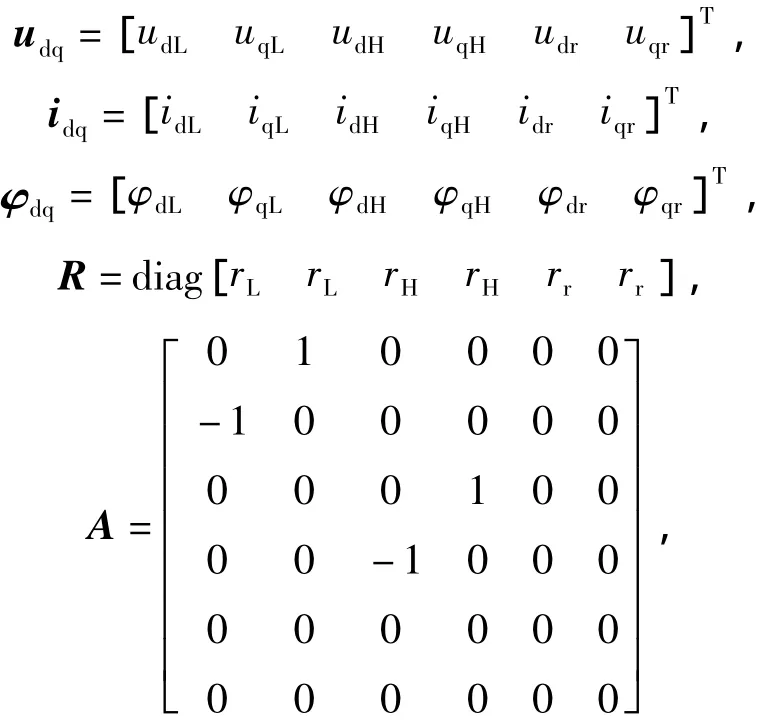

In this equation,

where D=d/dtis a differential operator,subscripts H and L express HV winding and LV winding respectively,subscript LH expresses the interaction between two windings,subscript r expresses the rotor winding,Lmis the mutual impendence between stator and rotor,wris the electric angle of the rotor.
Deducing from Eq.(1)and(2),the state equation of the system can be obtained as

3 Decoupled Control Strategy Based on Instantaneous Reactive Power Theory
3.1 Decoupled Control Principle of Dual Voltage Stabilized Generator
The vector graphic of dual voltage-stabilized generator is shown in Fig.3.In the figure,UHrepresents the terminal voltage of HV branch,ULthe terminal voltage of LV branch,Ethe induction EMF,IHqthe projection of HV branch current in the vertical direction ofUH,Imdthe projection of HV branch current in the horizontal direction of the induction EMF in air gap of magnetic field.

Fig.3 Vector graphic of dual voltage-stabilized generator
It is necessary to decouple the control so that two voltages can be stabilized with single VSR simultaneously.For example,ULcan be kept stable by adjustingIHqto compensate the exciting currentImwhen LV branch voltage varies due to load change.But,UHdoes not change,owing to three-phase reactive current does not flow through HV DC branch based on the theory of instantaneous reactive power.On the other hand,UHcan also be kept stable by regulatingImdto supply requiring active power when HV voltage changes,which does not influence 28 V DC voltage for the reason that exciting currentImwill not vary withImd.What mentioned above is decoupling control of both branches.
3.1.1 Decoupling control of LV branch
It can be seen from the vector graphic that the increase of LV branch load will lead to the decrease of compound exciting currentIm,which will reduceEandULaccordingly if there is no effective compensation.A proper method to solve this problem is to increaseIHq,thus the exciting currentImis compensated and the magnetic fluxφLis strengthened.

The strengthenedφresults in higherEandUL.Thereby,LV branch voltageULcan be stabilized under the conditions of reasonable control strategy and proper generator parameters.Meanwhile,UHis not influenced by three-phase reactive current and keeps stable.
Based on the instantaneous reactive power theory,the influence factor of DC voltage in HV branch is the active power rather than the reactive current.In other words,only if the active power is transferred from AC side to DC side of HV branch,the output DC voltage in HV branch raises.
3.1.2 Decoupling control in HV branch
The basic principle of decoupling control for voltage-stabilization of HV branch is shown in Fig.4.

Fig.4 Equivalent vector graphic for HV branch of loaded generator
If the load of HV branch increases as shown in Fig.4,the slip of the generator increases and the airgap magnetic filed frequency decreases;EandUHreduce toE'andU'Haccording to Eq.(2).In this case,the reactive currentIHqshould be increased to compensate the exciting currentImand strengthen the air-gap magnetic intensity,so that the induction EMF keeps stable.As mentioned above,the reactive currentIHqwill not influence the magnitude of DC voltage in HV branch.
In order to compensate the voltage drop due to load increase,the active currentImdshould be increased in this case,but the exciting currentImkeeps stable,thus the output 28 V of LV branch does not change.It means that the decoupling control of the double branches in dual stator-winding generation system can be implemented.
3.2 Design of Decoupling Controller
The structure of the decoupling control is shown in Fig.5.
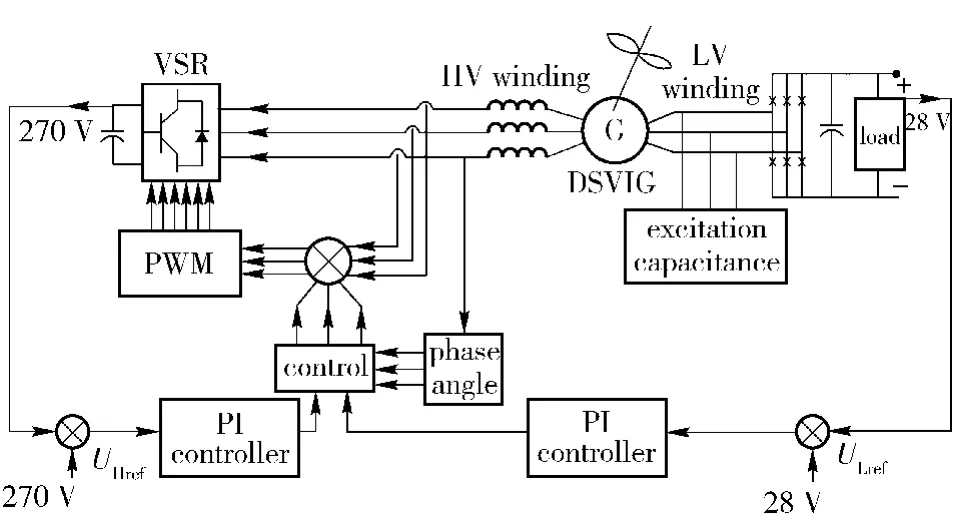
Fig.5 Structure of decoupling control
The three-phase winding of HV branch connects with VSR and outputs 270 V to heavy power loads.The three-phase winding of LV branch connects with the exciting capacitor and uncontrolled rectifier and outputs 28 V to low power loads.Both 270 V and 28 V can be stabilized by regulating the switch frequency and duty ratio of VSR in HV branch and so adjusting the exciting active and reactive currents,based on different control strategies.
The double close-loop structure for voltage-stabilization control is shown in Fig.6.The voltage control is adopted in external loop,which outputs the given values of active and reactive currents by PID regulator,while the current control is adopted in inner loop,the output of VSR is controlled by the hysteresis comparison of HV side three-phase current and reference value.

Fig.6 Structure for close-loop control
VSR possessing six switches in three arms can output three-phase AC voltage when the turn-on time and sequence of every two switches in each arm is adjusted[8],as shown in Fig.7.As VSR acts as an inverter,the DC voltageUHmust be higher than the maximum bus voltage in AC side,unless VSR will be a rectifier owing to the function of the parasitic diodes in six switches.That is the reason why 270 V is output by VSR side while 28 V from another side.

Fig.7 Structure for VSR connection
3.3 Control of Voltage Build-up Based on Hybrid Reactive Power Compensation
The principle of dual voltage-stabilized decoupled control is analyzed above.In this section,the control method for voltage build-up will be studied.Generally,it has reactive power compensation or hybrid reactive power compensation.In the frontal mode,a capacitor group will be controlled to engender reactive current by using remanence of generator,which is in-phase with the excitation current.As a result,the current becomes large and the voltages of the HV/LV side is built up gradually[9-10].However,the self-excitation capacitor must be large enough;moreover,the demagnetization reactive power is greater than the excitation reactive power in a wide speed scope.Aiming at the problem above,the control of voltage build-up based on hybrid reactive power compensation can be adopted,as shown is Fig.8.
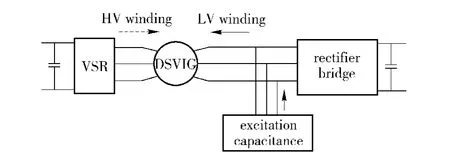
Fig.8 Flow of reactive power
In the figure,the flow of reactive power afforded by excitation capacitor is denoted by real line and the flow of reactive power afforded by VSR is denoted by dotted line.In the build-up process,the slip open-loop control is adopted,and the output of VSR is controlled by three-phase SPWM with constant modulation in order to keep the frequency of modulation wave smaller than the frequency of rotor.In this situation,DSVIG works in generation state and the remanence of generator is in-phase with the current of generator.The current increases and the voltages of HV and LV sides are built up.
The reactive power assignments of VSR and excitation capacitor are shown in Fig.9.The expected reactive power is denoted by gray rectangle in Fig.9(a),the reactive power change scope is denoted by real rectangle.If the reactive power is compensated,the reactive power afforded by excitation capacitor must be equal to that required by build-up process,as shown in Fig.9(b),while the reactive power afforded by VSR is shown as real rectangle.It shows that the demagnetization is greater than the excitation reactive power in a wide speed scope.Aiming at this problem,the capacity of capacitor is designed as gray rectangle in Fig.9(c)and the reactive power afforded by VSR is denoted as dotted line.

Fig.9 Reactive power assignments of VSR and excitation capacitor
4 Simulation and Analysis
In order to verify the hybrid generation system and its decoupling control method,simulations for voltage build-up process and dual voltage-stabilization control are carried out.
The voltage wave in voltage build-up process is shown in Fig.10,(a)for HV side and(b)for LV side.The simulation indicates that the voltage is built up in 0.4 s and the voltage ripples are less than 1 V and 0.1 V in HV and LV sides respectively.
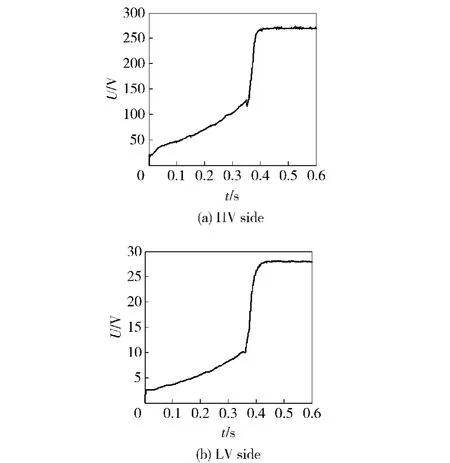
Fig.10 Voltage waves in build-up process
The responses of voltage and current in sudden 1.5 kW loading applied in LV side are shown in Fig.11,(a)shows the voltage and current in HV side,and(b)shows the voltage and current in LV side.The simulation indicates that the system has better antidisturbance ability,the recovery time is less than 50 ms,and the voltage fluctuations are less than 5 V and 1 V in LV and HV sides respectively.

Fig.11 Voltage and current waves of sudden loading in LV side
The response of voltage and current in sudden 1.5 kW loading in HV side is shown in Fig.12,(a)shows the voltage and current in HV side,and(b)shows the voltage and current in LV side.The simulation indicates that DSVIG has better anti-disturbance ability for HV side disturbance,the recovery time is less than 60 ms,and the voltage fluctuations are less than 6 V and 1.4 V in HV and LV sides respectively.

Fig.12 Voltage and current waves of sudden loading in HV side
5 Conclusions
A hybrid generation system based on dual statorwinding generator is proposed in this paper.Its structure and working principle are analyzed,and then,its key parameters are calculated and verified.The method to decouple two voltages based on the instantaneous reactive power theory and control method for voltage build-up based on hybrid reactive power compensation are presented,thus,both 28 V and 270 V are stabilized simultaneously.The simulation results show that the voltage stabilization accuracy and anti-disturbance ability of the system are improved greatly,compared with other existing generation systems.
[1]Olorunfemi Ojo,Innocent Ewean Davidson.PWM-VSI inverter-assisted stand-alonedual stator winding induction generator[J].IEEE Trans on IA,2000,36(6):1604 -1611.
[2]LIU Ling-shun,HU Yu-wen,HUANG Wen-xin.The application of improved genetic algorithm in optimal design of dual stator-winding induction generator with pwm converter[J].Transactions of Nanjing University of Aeronautics& Astronautics,2006,23(3):185-194.(in Chinese)
[3]WANG Dong,MA Wei-ming,LI Yu-mei,et al.Reserarch on dual stator-winging induction generator with static excitation regulator[J].Proceedings of the Chinese Society for Electrical Engineering,2003,23(7):145 -150.(in Chinese)
[4]LI Yong,HU Yu-wen,HUANG Wen-xin.Research on the dual stator-winding induction generator with variable speed operation[J].Proceedings of the Chinese Society for Electrical Engineering,2008,28(20):124 - 127.(in Chinese)
[5]ZHANG Ning.New type power supply system for armored vehicle[J].Armament Automation,2005,24(5):31 -32.(in Chinese)
[6]TANG Yun-miu,SHI Nai.Electric machine theory[M].Beijing:China Machine Press,2005:188 -191.(in Chinese)
[7]Roberto Leidhold,Guillermo Garcia,Maria Ines Valla.Field-oriented controlled induction generator with loss minimization[J].IEEE Trans on Industration Electronics,2002,49(1):147 -155.
[8]Silva S R,Lyra R O C.PWM converter for excitation of induction generators[C]∥The European Power Electronics Association Proceedings of the 5th European Conference on Power Electronics and Applications,Brighton,1993:174-178.
[9]Bhadra S N,K Venkata Ratnam,A Manjunath.Study of voltage build up in a self-excited variable speed induction generator/static inverter system with DC side capacitor[J].Proceedings of the IEEE International Conference on Power Electronics,EnergySystemsforIndustrial Growth,1996,15(2):964 -970.
[10]Chen F.Capacitance requirements of self-excited induction generator[J].IEEE Transon Energy Conversions,1993,8(2):304 -311.
猜你喜欢
杂志排行
Defence Technology的其它文章
- Fault Diagnosis of Bearing Based on Integration of Nonlinear Geometric Invariables
- Influence of Structure Parameters of Double-angle Liner on Jet Formation
- A Novel Kernel for Least Squares Support Vector Machine
- Experimental Investigation on the Ballistic Resistace of Metal Plates Subjected to Impact of Rigid Projectiles
- Research on Matching Relationship Between Number of Initiation Points and Charge Diameter
- Research on Top-layer Planning and Overall Design Project Decision of Weapon System Based on Analytic Hierarchy Process
